The AMD 3rd Gen Ryzen Deep Dive Review: 3700X and 3900X Raising The Bar
by Andrei Frumusanu & Gavin Bonshor on July 7, 2019 9:00 AM EST** = Old results marked were performed with the original BIOS & boost behaviour as published on 7/7.
Benchmarking Performance: CPU Rendering Tests
Rendering is often a key target for processor workloads, lending itself to a professional environment. It comes in different formats as well, from 3D rendering through rasterization, such as games, or by ray tracing, and invokes the ability of the software to manage meshes, textures, collisions, aliasing, physics (in animations), and discarding unnecessary work. Most renderers offer CPU code paths, while a few use GPUs and select environments use FPGAs or dedicated ASICs. For big studios however, CPUs are still the hardware of choice.
All of our benchmark results can also be found in our benchmark engine, Bench.
Corona 1.3: Performance Render
An advanced performance based renderer for software such as 3ds Max and Cinema 4D, the Corona benchmark renders a generated scene as a standard under its 1.3 software version. Normally the GUI implementation of the benchmark shows the scene being built, and allows the user to upload the result as a ‘time to complete’.
We got in contact with the developer who gave us a command line version of the benchmark that does a direct output of results. Rather than reporting time, we report the average number of rays per second across six runs, as the performance scaling of a result per unit time is typically visually easier to understand.
The Corona benchmark website can be found at https://corona-renderer.com/benchmark
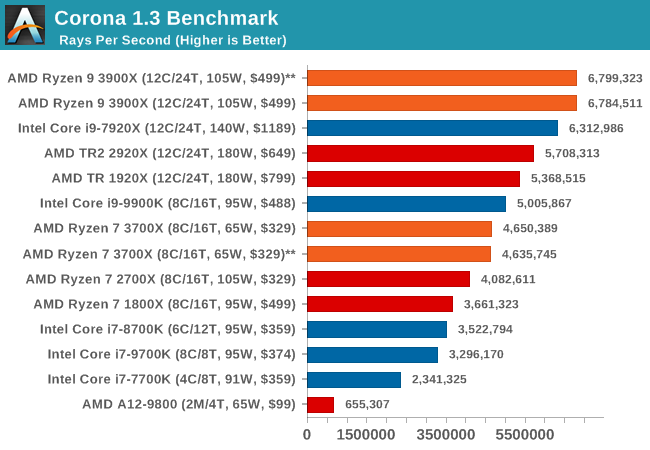
LuxMark v3.1: LuxRender via Different Code Paths
As stated at the top, there are many different ways to process rendering data: CPU, GPU, Accelerator, and others. On top of that, there are many frameworks and APIs in which to program, depending on how the software will be used. LuxMark, a benchmark developed using the LuxRender engine, offers several different scenes and APIs.

Taken from the Linux Version of LuxMark
In our test, we run the simple ‘Ball’ scene on both the C++ and OpenCL code paths, but in CPU mode. This scene starts with a rough render and slowly improves the quality over two minutes, giving a final result in what is essentially an average ‘kilorays per second’.

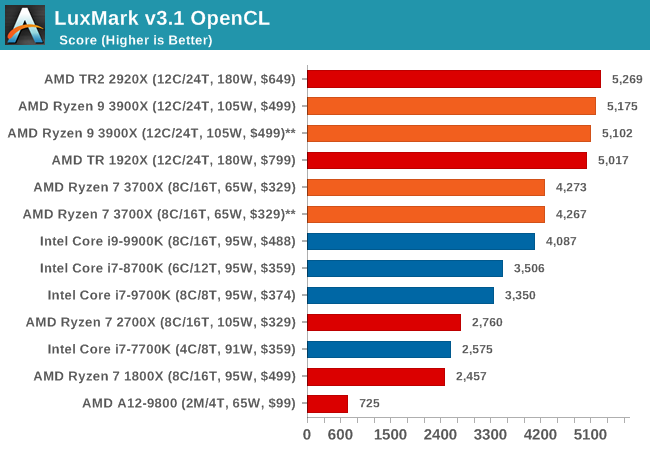
POV-Ray 3.7.1: Ray Tracing
The Persistence of Vision ray tracing engine is another well-known benchmarking tool, which was in a state of relative hibernation until AMD released its Zen processors, to which suddenly both Intel and AMD were submitting code to the main branch of the open source project. For our test, we use the built-in benchmark for all-cores, called from the command line.
POV-Ray can be downloaded from http://www.povray.org/
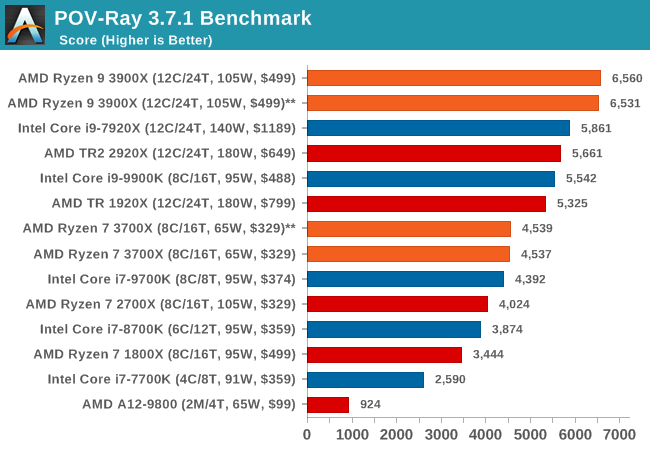
Cinebench R15
The latest version of CineBench has also become one of those 'used everywhere' benchmarks, particularly as an indicator of single thread performance. High IPC and high frequency gives performance in ST, whereas having good scaling and many cores is where the MT test wins out.
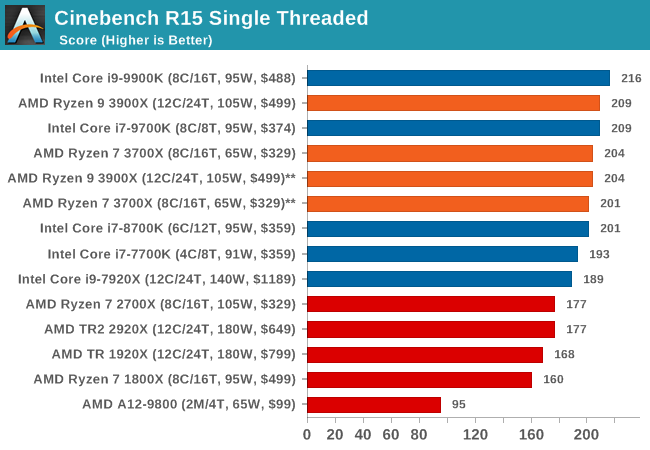
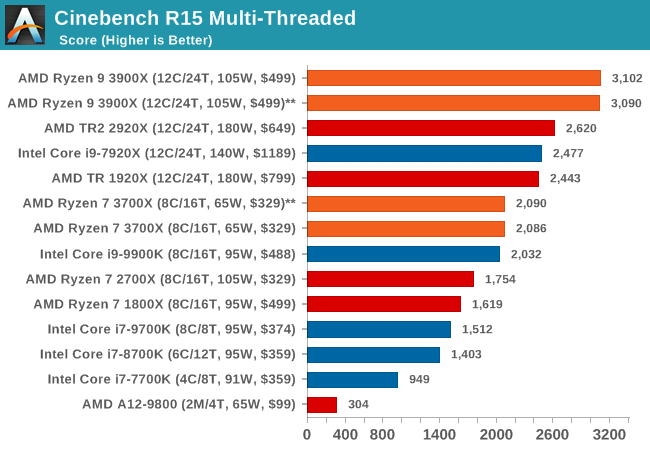











447 Comments
View All Comments
John_M - Sunday, July 7, 2019 - link
Yes. The integrated memory controller is on the IO die, which is part of the Ryzen SoC, not the chipset.BushLin - Monday, July 8, 2019 - link
Right now, there's no indication what CL / timings are applied to all the other systems. CL16 is indeed bottom of the barrel for DDR-3200, you would hope there's no shenanigans with Intel getting CL12 DDR-2666. Why not just run all the systems with the same DDR-3200, it's not like they can't do it.profiaudi - Wednesday, July 10, 2019 - link
Not to be too rude, but the IMC is on the io chipLet, not the chipSet. The chipset actually has an important role for the memory speed, in that a chipset defines a platform and a platform imposes requirements on the power supply and trace routing. While the IMC in 3rd gen can handle 3200MT/s+ completely fine, it is guaranteed to do so only one X570. Anything older is a dice roll as the boards were not designed for such speeds (not a requirement for the older platform).waja - Tuesday, July 23, 2019 - link
Do you know george stevenson story?He earn 3657$ every month at home just working few hours on internet see more by open this connection and click home button.FOR MORE INFORMATION COPY THIS SITE.......... www.online-3.comAndrei Frumusanu - Sunday, July 7, 2019 - link
Just as note for those who haven’t been following: This review wasn’t written by our usual resident CPU editor, Dr Ian Cutress as he unfortunately the timing didn’t work out. We only had a few days time with the new Ryzen CPUs, as such, you might noticed a few bits and pieces missing in our article that we’ll try to address in the next hours and days. We’ll be trying to update the piece with more information and data as soon as we can. Thanks.Also huge thanks to Gavin Bonshor who actually did all the testing and collected all the data for this review, thumb up to him.
plonk420 - Sunday, July 7, 2019 - link
hoping a speedy recovery for him! loved his video with Wendell!loving the article, too. don't suppose you could test cross-CCX latency?
plonk420 - Sunday, July 7, 2019 - link
e.g. pcper.com/2017/06/the-intel-core-i9-7900x-10-core-skylake-x-processor-review/3/main interest is if it is low enough to be harnessed by RPCS3 (PS3 emulator)
ballsystemlord - Sunday, July 7, 2019 - link
CCX benchmarks would be nice.IF power benchmarks were also done last time and probably in the works.
shakazulu667 - Sunday, July 7, 2019 - link
Are Intel results with or without spectre et al mitigations?Ryan Smith - Sunday, July 7, 2019 - link
They are with Spectre and Meltdown mitigations. They are not new enough results to include anything for Fallout/ZombieLoad.